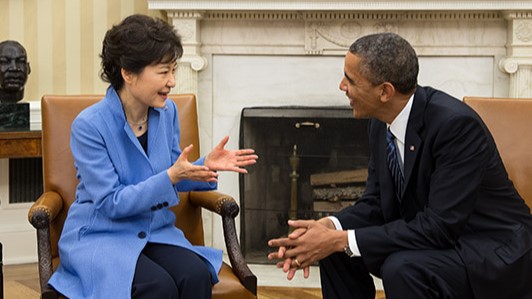Greeted with much fanfare in 2012, the Obama administration’s so-called pivot to the Asia-Pacific region has of late been beset by doubts and distractions. Developments in the Middle East and Europe have consumed a great deal of top-level attention, and declining U.S. defense spending has raised concerns that the military aspect of the rebalance may simply not be feasible.
On top of this, the administration is working to convince two of its most important regional partners, Japan and South Korea, to move past an especially rough diplomatic patch and form a durable and consistent partnership on security and other matters. These efforts received at least a symbolic boost earlier today, when South Korean President Park Geun-hye and Japanese Prime Minister Shinzo Abe agreed to take part in a trilateral summit with U.S. President Barack Obama next week in The Hague.
The summit will be the first face-to-face meeting between Park and Abe since they took office and will take place on the sidelines of the 2014 Nuclear Security Summit.
But in order for the administration to mend fences between South Korea and Japan, it will need to make sure that U.S. relations with both countries are on track.
Earlier this month, Assistant Secretary of State for the Bureau of East Asian and Pacific Affairs Daniel Russel
told the Senate Foreign Relations Committee that U.S. engagement in the Asia Pacific was “comprehensive” and stated that Japan and South Korea are at the “center” of the administration’s rebalancing strategy.
U.S. relations with both countries have “never been stronger,” he said. At the same time, though, he admitted that “strained” relations between Japan and South Korea created the need for “prudence and restraint in dealing with difficult historical issues.”
Speaking this morning at the Center for Strategic and International Studies, former senior Bush administration State Department official Richard Armitage had a less upbeat assessment of the U.S. relationship with Japan. While he praised some of Abe’s recent actions, such as supporting the Trans-Pacific Partnership and putting Japan “on the side of the West” in reaction to Russia’s actions in Crimea, he called the U.S.-Japan alliance “troubled.”
Troubles in the alliance come from the awkwardness of the situation between Japan and South Korea as well as broader questions of Japanese confidence in U.S. commitments. He said that Japanese diplomats are increasingly parsing statements from senior U.S. policymakers and wondering how the United States will respond when confronted with provocations in the Asia-Pacific region that fall below the level of all-out war.
But apart from U.S. diplomacy in the Asia-Pacific, it has become increasingly clear that the ability of the United States to sustain—much less increase—its forward-deployed military presence in the region faces a number of limitations. Earlier this month, Assistant Secretary of Defense for Acquisition Katrina McFarland said that the rebalance
“can’t happen” given recent budget cuts. Although she later publicly walked back this statement, it was widely reported and struck some observers as a candid admission of the fiscal realities facing the Pentagon.
To take one example, the Pentagon’s recent budget request for fiscal year 2015 capped the number of Littoral Combat Ships (LCS) at 32, rather than the 52 ships the Navy had originally planned to acquire. The LCS program had been justified partially based on the expectation that the ships would be able to interact more easily with the smaller navies of some states in Southeast Asia and elsewhere compared to larger platforms. Ultimately, however, Secretary of Defense Chuck Hagel and others
decided that the LCS might not have “the independent protection and firepower to operate and survive against a more advanced military adversary and emerging new technologies, especially in the Asia Pacific.”
At the same time, China recently announced that it would increase its defense budget by over 12 percent, though when inflation and China’s opaque accounting practices are figured in the actual increase could end up being somewhat less drastic. But even so, China is continuing to build up its military and its naval forces in particular.
A report last month from the Congressional Research Service stated that China’s naval modernization
is oriented toward the following goals: gaining the capabilities necessary for “addressing the situation with Taiwan militarily,” asserting territorial claims in neighboring seas, enforcing the right to regulate trade off its borders and asserting China’s great-power status while displacing U.S. influence.
Another recent report, by Brian Weeden of the Secure World Foundation, suggested that China may also be working on a new ground-based anti-satellite weapon, a sign that China may be working to negate the U.S. advantage in space as well as at sea.
Despite these trends, the United States will be in a better position to sustain its strategy in Asia if it can get its allies to cooperate, including with one another. But Japan and South Korea are suffering from “fatigue” with regard to their mutual grievances, Armitage observed, and the points of dispute between them are enduring and will take a long time to resolve. All three countries will need to be patient.

